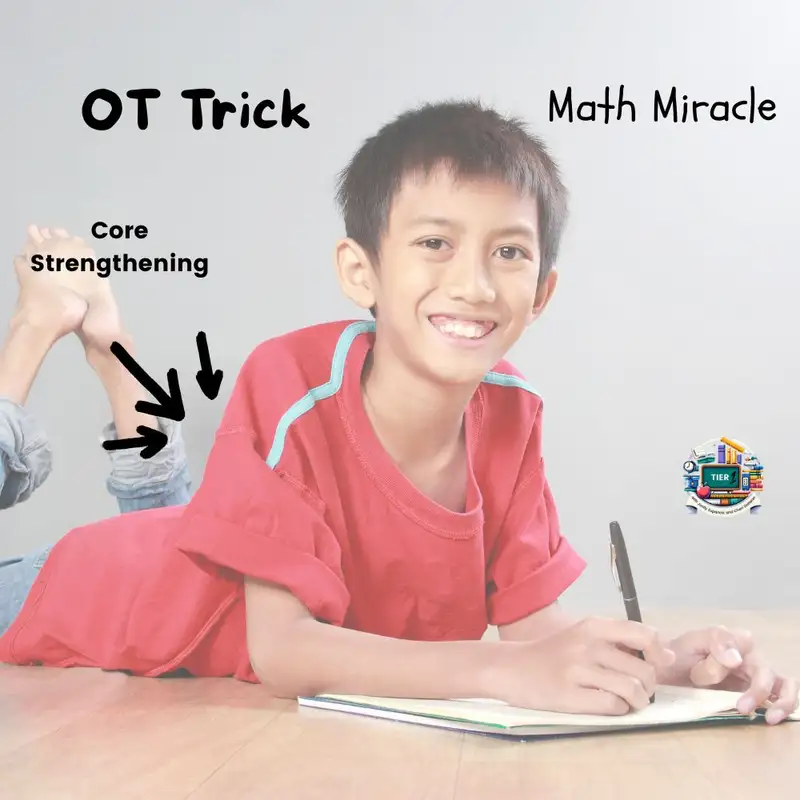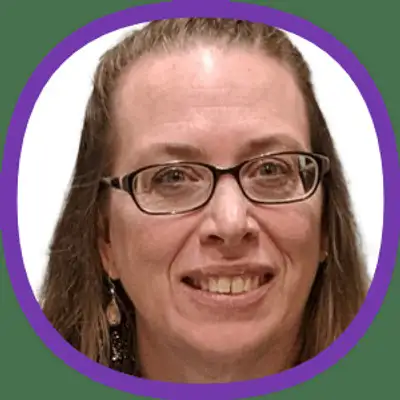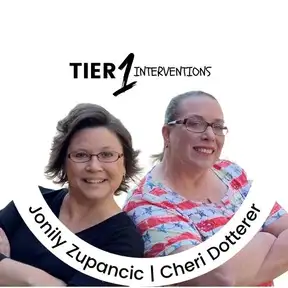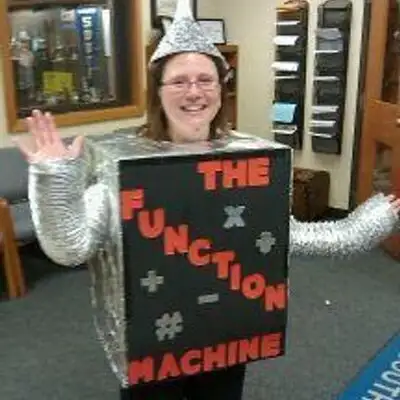
The Geo Board Hack That Fixed Handwriting AND Math Anxiety! S2 E29
And after this conversation, I'm
really thinking to like a few specific
kids who can't take notes at the seat
can't do, or struggle I should say.
They're really struggling to look up and
look down, and I hadn't really picked
up on that specifically before, but
when they go to boards, they are on it.
They're right there.
They're zoned in, they're leading
the group, they're taking charge.
Hey everybody.
Welcome to Tier One Interventions podcast.
We are here today to
talk about a geo board.
Geo board is a very interesting device
and when I first looked at it, I only
saw it from an occupational therapy
perspective where we were working on
it with hand strengthening and such.
But I come to see how valuable
it is as a math tool as well.
Today we are going to blend the math
and the occupational therapy together
so that you can understand better
what it looks like to have a geo board
as a intervention in your classroom.
Welcome Jonily to today's episode
and everybody else who is with us.
I want to move on to chunk one and
chunk one is gonna bring us back
to the math and we're gonna be
toggling back and forth academic
math, academic non-academic all day.
But I'm also gonna connect this to
a comment that Natalie put in the
chat and Natalie says, some of my
most struggling kids do best when
we work at vertical whiteboards.
And this could be why.
It's exactly why I wanna give a
shout out to in the math world.
You all know him as Peter.
That's all I have to say, Peter.
Hey, if someone is listening to
this tag, Peter, get Peter on here.
Have him listen to this podcast.
We love you, Peter.
And Peter has written the
book and many other resources,
building Thinking Classrooms.
Natalie is a full implementer
of the techniques and
building thinking classrooms.
And I will say that when we are,
when you're reading Building Thinking
Classrooms and you're adding some
of these strategies into your cl
into your math classroom, because
it's for math classrooms, it's not
just for math classrooms, but the
book was written for math classrooms
with specific math content.
As a math teacher, we're like, oh yeah,
I can do that with my math content.
And so we constantly refer
back to the math content.
But what we're missing in Peter's
writing is the neuroscience.
And in little pieces, he does point
out the brain-based neuroscience for
why he gives the strategies he gives.
But let's face it, if he does too much of
that, we kind of tune out as a classroom
teacher, we just want those grab and goes.
We just want just tell me
what to do in my classroom.
I don't care why I am doing it, but
we do have to care why we're doing
it, because then we're going to do
it more frequently because we're
gonna start to see the benefits.
Also in the book, Peter does talk in
a chapter about flow and flow state,
which Sherry shares a lot with us,
that neuroscience perspective on how
to get students to focus and then how
to get kids into a flow state where
they're in the zone and nothing can
relieve their attention because they
are so focused on the task at hand.
But Natalie, do you wanna talk talk
to us just a little bit about some of
your successes with vertical surfaces
that related to Chunk Zero, but then
I'm gonna move this back into Chunk
one for today, which is one of the
mathematics pieces of using the Geo Board.
Natalie?
Yeah.
I've definitely noticed successes
with all of my kids, but I've always
noticed that some of my most struggling
kids are the most successful.
And after this conversation, I'm
really thinking to like a few specific
kids who can't take notes at the seat
can't do, or struggle I should say.
They're really struggling to look up and
look down, and I hadn't really picked
up on that specifically before, but
when they go to boards, they are on it.
They're right there.
They're zoned in, they're leading
the group, they're taking charge.
So like now I can really pinpoint some
of those specific kids and see, that
where, why they might be struggling.
They're very capable.
Now I have more strategies to help them,
succeed and explains why that sit, why
that, switch is so much better for them.
But hashtag building thinking
classrooms, vertical non permit surfaces.
I've been in it for I
think this three years now.
And it is a game changer and it goes
so nicely with everything we do.
And it's not another thing.
It's just a different way.
And it's awesome.
And the outcomes that I know you've
said that you get from this is focus on
content, increased content understanding
and as well as engagement, as well as
discussion, as well as active learning
as opposed to passive learning.
And let's think about
this vertical surfaces.
Kids are on the vertical, but
they're also standing, which is
another thing that Theresa said.
So all of these practices coming together,
all we have to do is have kids stand
work on a vertical surface, and that is
going to solve many of the issues that
we're having in our math classrooms.
Yes.
And it also provides
accessibility and user friendly
mathematics in our classrooms.
Sherry, oh, I love your comment.
Vertical surfaces decrease the
need to extend risks for writing.
Yes.
When you're writing, when you're writing
on a flat surface, your wrist needs to be.
Extended to about 30 degrees to
get your fingers at the position
that they can actually move to.
When you're on a vertical
surface, guess what?
You can get those fingers in that
position so that they can and they
don't have to extend their wrist.
So there's twofold reason here.
To use a vertical surface and mechanically
in your wrist, it is to help give
that those muscles in the back of
your arm chance to get strengthened
so you don't have to de open up your
wrist as far so that by the time that
you are going back down to a flat
surface, these muscles are strong
enough that they can actually do it.
Fantastic.
And those kids who can't do a vertical
surface, but you want a vertical surface,
put 'em on their belly with a clipboard
and it's the same thing, but they're on,
they're laying down and you've decreased
the gravity they have to deal with.
You know what, Theresa, this is
funny because chunk number two today
is called teenage tummy time, and
we are going to, we're going to
tag right back to that in a moment.
For occupational therapists, one thing
that we do a lot is we score figures that
look like this with different standardized
tests that we have available to us.
Utilizing those progressions
that Jonily lined out.
Will help us in our upgrading
and downgrading of helping our
students manipulate the different
way, the different types of paper
that we might present to them.
When we're looking at design copying,
think about how it is related to
the geo board and the mathematics.
And so it's looking at the de
the design copying activity from
a whole different perspective.
'cause I've never looked at it from
that perspective before, but when
we started talking ahead of time, I
wanted to make sure that I showed that.
And it was an older copy
of a standardized test.
And I didn't show you the
whole standardized test.
I showed you two of the I images from it.
But students struggle to do those
complicated designs like that and they
also will have trouble putting 'em on
the physical geo board, which is why
unstructured play with the geo board.
Dot paper, just unstructured, un
facilitated play in just creating
pictures, image images or abstracts
is not only gonna benefit students
non-academically and functionally,
but it's going to benefit students
mathematically because they are
going to have a feel, a sense,
a taste, a touch, a smell.
It's gonna engage all of their
senses in how shape and images
work mathematically so that then we
can attend to precision when we're
defining shape function using those
tools, which students have a hard time
mathematically and non mathematically.
Yeah.
I'm just processing a lot.
My mind is blown today oh my gosh.
Oh my gosh.
So many things.
Give us a few takeaways, Natalie.
I. I, one thing I wrote in the chat
earlier I feel pretty good with
my content, but then picking up
these brain science things is like
the next maybe big layer for me.
I am really excited to continue to
learn more and just dive more into
that and just seeing that connection,
just knowing that the whiteboards work
for my students, but then now being
able to pinpoint specific students
and oh, okay, I'm seeing that more.
And even was thinking further.
Like one kid writes, oh, ridiculous.
This doesn't even look like
handwriting on paper, but at the
board I can read everything he writes.
It's I never made that
connection till today.
I am like, okay, I'm just
developing those different things.
So I'm really excited to, and I
think really important to learn more
about the brain science and make
those connections, but just even the
connection to content and pizza problem
and diagonals and like thinking about
air parallelograms and area and all the
things, I'm just, Ugh, I'm so excited.
What a great session.
So excited.
Awesome.
Awesome.
When he's so Natalie, so when
he is working at his desk, not
everybody has access to a lamp
board, but you can use a binder.
Just give him a binder and see if
that works for him and just put his
worksheet on the binder, a three
ring binder, you have various sizes.
Just see if that works for him
and see if just changing the
height of his paper helps him.
I will try that.
Great idea.
The binding being away from him so
that it's on the slant this way.
Sometimes they collapse and you just
stick stuff in it, to stop the collapse.
But otherwise, they're inexpensive.
They probably have 'em in
the building three, 3, 2, 1.
You can vary the size based on
what he needs, which creates
that slant using a, yeah.
Couple inch binder.
Dang.
Yes.
That's so easy.
Do you know how many schools
throw away two inch binders.
Collect those things
and use 'em for slant.
And you know what you can use
'em for too, is you can use
them as a wedge on your seat.
So you know how kids they, you can
turn them so that the wedge goes,
so they angle, you put the three to
the front, so they angle them back
in the seat or the other way around.
So they can angle either direction.
All you do is put some, nice, tape
on it, make it nice and sturdy
because you may not have the money.
I don't have a budget to do anything.
Yeah.
So you just make 'em nice and
sturdy and you can make 'em as
wedges for the chair and duct tape.
Duct tape, duct tape cover.
So it's almost the end of the year.
There you go.
It's thrown away.
Binders, one inch, two
inch, three inch binders.
Collect all the old binder
binders and cover them with
duct tape to make them sturdy.
You've got slant surfaces and you've got
sitting slanted surfaces or for the feet
on the bottom, if you, if a kid can't, you
gotta make sure their feet are stable on
the floor, stack a couple, there you go.
Rest, you get your feet
touching the floor.
Love it.
Watch the duct tape and
the writing surfaces.
Okay?
Because they will, that will
influence their writing because
of the duct tape texture.
One thing that you can do then, if you're
gonna use it for a writing surface, is
put construction paper over the duct tape.
It will help buffer that
texture a little bit.
It won't solve it all, but if
you're writing on a construction
paper, it's a better blot feel
than even writing on the hard desk.
That ends segment two,
chunk one of the Geo Board.
Check in next week for more discussion
on how the Geo Board can work
in your math classroom and your
occupational therapy intervention.
If you'd like to learn the and hear the
entire instruction on the geo board,
you wanna go to disability labs.com and
look for the Geo Board in our courses.
Talk to you next week.
Episode Video
Creators and Guests


